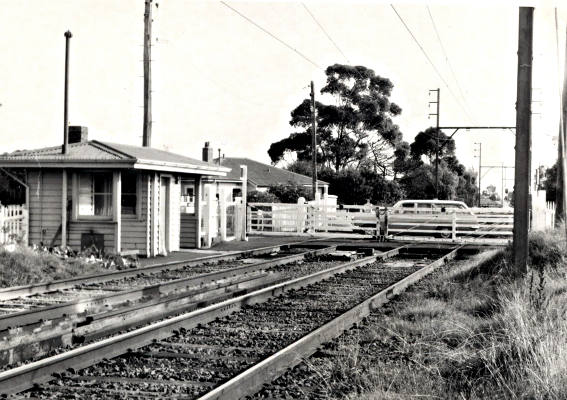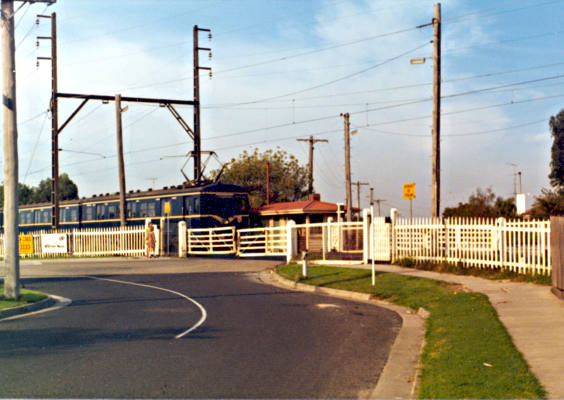The Highett Railway Disaster

Wickham Road Railway Crossing, Highett, 1984. Courtesy Moorabbin Historical Society.
On the night of Monday 23 March 1925, an eagerly anticipated social occasion was arranged at the house of Mr John Mathiesson of Point Nepean Road, Moorabbin to raise funds for the Mentone Catholic Church. But anticipation soon turned to apprehension when a number of guests from Sandringham failed to show. Amongst the missing was 32 year old electrician, Clarence McDonnell (c1893-1925) of Park Street, South Melbourne, who was to play the piano for the forty guests.
Shortly after 8:10pm on that fateful evening, travelling in his Ford vehicle with wife Pearl (c1895-1925) and infant son Raymond, McDonnell collected the last of five passengers from Grange Road, Sandringham. The group of eight then continued east before heading north along Bluff Road to Wickham Road. By the time they were 150 yards from the Wickham Road railway crossing it was just after 8:23pm. The crossing which intersected with Worthing Road, was manually operated by William George Resuggan (1865-1932) who resided at the gatekeeper’s cottage on the north-west side with his wife Florence Emily née Doggett (d 1957) whom he married in 1889 at Buninyong, Victoria. Resuggan had been in the employ of the Railways department since 1888 and had been gatekeeper at Highett for the last sixteen years. Residents described him as “very careful” and “attentive”, a man who had often “made himself disliked for checking people who wanted to get through”.
The crossing arrangements consisted of four gates with a bell warning, and signal system on the ‘down’ line. The crossing handled some 160 cars a day. It was, however, potentially dangerous for trains travelling towards Frankston as the signal south of Dane Road was just 200 yards away allowing for less than ten seconds until the train reached the crossing. It was the type of crossing that allowed for little margin of error.
At the Moorabbin signal box, signalman Alfred Read had commenced his evening shift at 3:35pm that day and was waiting patiently for the 7:31 ‘down’ parcel goods train. Running fifteen minutes behind schedule due to delays, it finally arrived at 8:23pm. Shortly after, Read then sent separate warning signals to both the crossing and Highett station. As the train passed the signal protecting the crossing, the driver of the train, John McNee, a 35-year veteran with an “exceptionally good record as a careful driver” noticed the home signal at “proceed”. At this stage the train was travelling an estimated 39 miles an hour.
The scene was now set. Just after 8:20pm, James Cuddigan, a student of Highett was driving north along Worthing Road with his brother Simon as passenger. The car approached the crossing and Cuddigan sounded his horn for Resuggan to open the gates as railway regulations stipulated that after dark, crossing gates must be closed to road traffic until the last train at midnight. On hearing the horn, Resuggan came from his cabin and opened the north-eastern and south-western gates without putting the signal at “danger”. Cuddigan then continued on his journey and Resuggan closed the south-western gate. Not far behind within sight approaching the crossing along Wickham Road was Clarence McDonnell and his eight passengers. Burdened by the heavy load and the slight uphill incline, the going was slow in the darkness. As it passed the house of Herbert Chamberlain, the car “did not appear to be going very well”. Resuggan waited until the vehicle approached the crossing before opening the north-western gate. “Pull the stick, mum!” he shouted and Mrs Resuggan put the signal at “danger”. He turned and suddenly noticed the lights of the approaching ‘down’ parcel train hurtling towards the crossing. McNee had not seen the signal. “For God’s sake shake it up!”, he pleaded at McDonnell, but the car was moving slowly at walking pace and he was unable to increase the speed. Crucial seconds passed, but it was too late and the train smashed through the crossing killing all the occupants instantly. The scene was one of utter devastation, bodies were so “shockingly mutilated” that all “resemblance to a human being had disappeared” and “women in the crowd uttered hysterical cries and men turned away in horror” when the coverings were removed to identify the victims. It was to be another two hours before they were removed to the morgue.

Railway Crossing from Worthing Road, c1984. Courtesy Moorabbin Historical Society.
On 7 April, the coronial inquest before Mr D. Berriman P.M opened at the city morgue; where over five days conflicting evidence was heard from some thirty witnesses. James Montgomery, engineer from the Railways department gave evidence that warning lights were fitted on the south-east and south-west gates but as neither gates were open to road traffic, McNee received no warning. Alfred Murphitt, block and signal inspector who arrived at the scene shortly after 10:00pm that night, testified that the signal was “working properly and was in good order” as was the bell in the gatekeeper’s cabin. Murphitt further stated that he examined the record at the Moorabbin signal-box and saw that “the warning had been given” by Read. Albert Stamp, superintendent of locomotive stated he undertook some tests and found that he “could not get a reasonable view of [the red warning lights] until…I was 200ft from the gates” as they were not “focussed on the line” correctly. When asked by the coroner “should the gatekeeper not be prohibited from opening the gates after he has received the warning signal” from Moorabbin, he replied “it would make safety more complete”. Herbert Chamberlain when asked “was the [Moorabbin] municipal electric light outside the gate burning that night” replied “it was out that night and the night before”. Mrs Blanche Comber of Mentone who was 50 yards from the accident gave damning evidence against Resuggan that “he had opened the gates to let them through into danger”. Resuggan’s son Harold gave evidence that he had known the “bell to miss on several occasions” and once “reported to the stationmaster [Edward Fallon] at Highett that the bell was not working”. John Ashworth, assistant chief engineer for the Railways department could not “make any suggestion whatever to increase the safety” of the crossing believing that if “regulations are observed, such things would not occur”. When an incredulous Coroner said “you say all this, despite the department’s policy of ‘safety first’” Ashworth replied “that is only a slogan”. Summing up his verdict, the Coroner found that “there had been a certain amount of conflict in the evidence” and was “quite prepared to believe that Resuggan did not hear the warning bell” from Read as not one witness testified to hearing it ring, but nonetheless found the eight victims died through his criminal negligence. Bail was given on a surety of £50 and a personal bond of a like amount.
At the Court of General Sessions on 10 June before Judge Woinarski and a jury of twelve, Resuggan pleaded “not guilty” to the charge of manslaughter. After a three day trial, the jury agreed, finding the tragedy was due to the fault of the system and not through human negligence. After being taken to the scene of the collision “where they inspected the crossing, the gates, the signal and the warning bell”, the jury took the opportunity of making a number of recommendations to improve safety. The first was “that the gates and signal should be operated conjointly by the one lever”. The second that “a bright light be placed in a position to which it will illuminate the whole of the crossing”, and finally that “the red light on the gate should be fixed so that it will show at all angles instead of one angle as at present”.
And so it was left for the families of the victims to face the appalling reality in what The Age described as “the most terrible level-crossing smash in the history of the State”. Six children were left orphans, while another nine were left without the family breadwinner, the youngest just three years old. For Clarence McDonnell, his wife and infant son, they left behind two young boys Vernon aged seven and six year old Keith. Also travelling in the car was McDonnell’s father, Michael Joseph McDonnell (c1865-1925), market gardener of Highett Road, Sandringham. The McDonnell's were interred at the Melbourne General Cemetery.
Bendigo-born Martin Foley (1888-1925) residing at Mena - Highett Road, Sandringham lived next door to McDonnell. He was reluctant to leave his wife Evangelina Hilary née Ruddick (c1889-1972) and six children owing to her dislike to leaving them behind late at night. A house painter by profession, Foley served in the Great War
Edward Christopher Shacklock (c1887-1925) and his wife Josephine Saphronia née Ronkey (c1885-1925) resided at Anabert - Holzer Street, Sandringham with their four children. Married in 1907 they had intended to go to the local picture show that night but changed their minds. Shacklock’s father Charles (d 1946) sued the Victorian Railways Commissioners and was awarded £1,456 under provisions of the Wrongs Act 1915.
The last of the victims was Geelong-born Ena Corbett Grace (1906-1925) of Grange Road, Sandringham. Employed as a saleswomen with the local “Semco factory” of Black Rock, she was the sole support of her family of four; mother Annie Elizabeth Grace née Grossman (d 1962), and siblings Rannock Pierce (1913-75), Valda Margaret (b 1911) and James Albert (1905-61).
They were all interred side by side at the Brighton General Cemetery on 25 March 1925.
